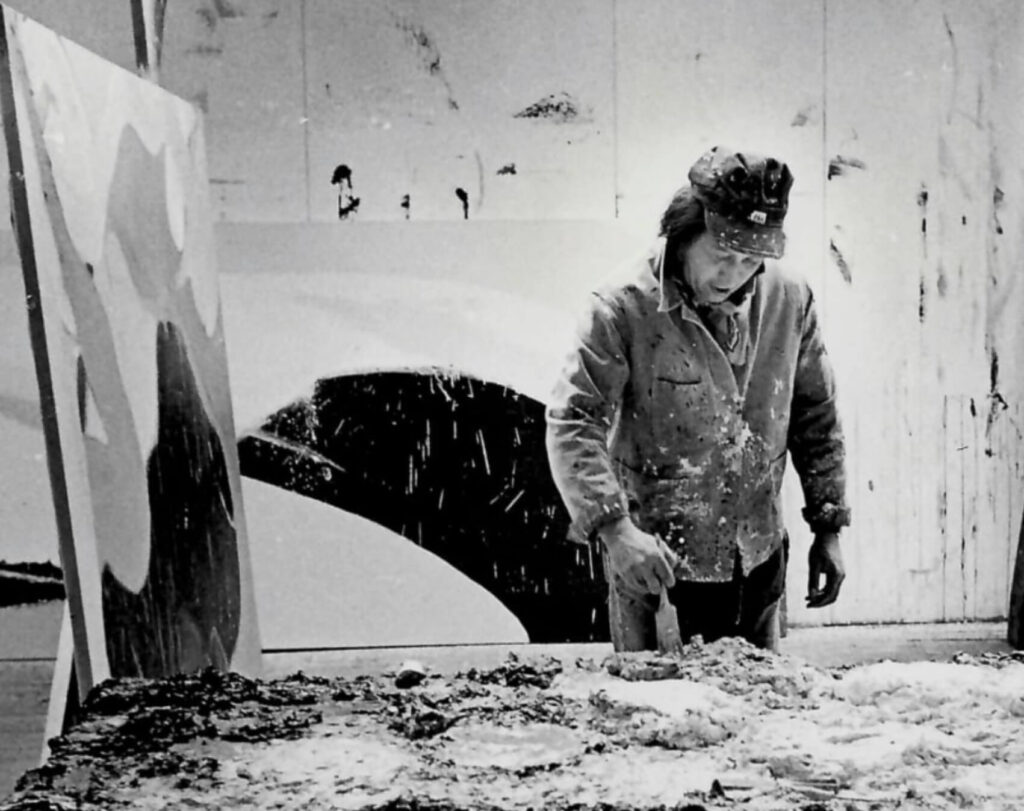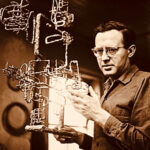Norman Bluhm
Norman Bluhm (1921-1999) was a dynamic and influential figure in the Abstract Expressionist movement, known for his energetic and colorful canvases that capture the intensity and spontaneity of mid-20th-century American art. His work is characterized by bold brushstrokes, vibrant colors, and a unique blend of abstract and figurative elements, reflecting his deep engagement with both the formal and expressive possibilities of painting.

Early Life and Education
Norman Bluhm was born on March 28, 1921, in Chicago, Illinois. From an early age, he exhibited a strong interest in art, which was nurtured by his family and early schooling. After graduating from high school, Bluhm attended the Armour Institute of Technology (now the Illinois Institute of Technology), where he initially studied architecture. However, his studies were interrupted by World War II.
During the war, Bluhm served as a B-26 bomber pilot in the United States Army Air Forces. This experience had a profound impact on him, shaping his worldview and later influencing his artistic vision. After the war, Bluhm decided to pursue his passion for art more seriously. He moved to Paris in 1947, where he studied at the prestigious École des Beaux-Arts and immersed himself in the vibrant postwar art scene.
Artistic Development in Paris
While in Paris, Bluhm befriended several key figures in the European avant-garde, including Alberto Giacometti and Jean-Paul Riopelle. He was also influenced by the works of Pablo Picasso and Henri Matisse. During this period, Bluhm’s work began to evolve from a focus on figurative and classical elements to a more abstract and expressive style.
Bluhm’s exposure to European modernism and his interactions with leading artists of the time were crucial in shaping his artistic development. He began to experiment with bold colors, dynamic compositions, and gestural brushwork, laying the groundwork for his later work as a key figure in Abstract Expressionism.
Return to the United States and Abstract Expressionism
In 1956, Bluhm returned to the United States and settled in New York City, which was then the epicenter of the burgeoning Abstract Expressionist movement. He quickly became an active participant in the city’s vibrant art scene, exhibiting alongside contemporaries such as Jackson Pollock, Willem de Kooning, and Franz Kline.
Bluhm’s work during this period is characterized by its vigorous brushstrokes, explosive color palettes, and dynamic compositions. He developed a unique style that blended the gestural freedom of Abstract Expressionism with a sensitivity to form and structure. His paintings often featured swirling, organic shapes and a sense of movement and energy that captured the viewer’s attention.
Important Artwork: “Birthday” (1962)
One of Norman Bluhm’s most celebrated works is “Birthday” (1962), which exemplifies his mature style and his ability to fuse abstract and figurative elements in a cohesive and visually striking composition.
“Birthday” (1962)
“Birthday” is a large-scale painting that showcases Bluhm’s mastery of color, form, and gesture. The canvas is dominated by a dynamic interplay of bold, sweeping brushstrokes in vibrant hues of red, blue, yellow, and black. The composition is both chaotic and harmonious, with a sense of movement and rhythm that draws the viewer into the painting.
At first glance, “Birthday” appears to be purely abstract, with its energetic lines and vivid colors. However, upon closer inspection, one can discern figurative elements embedded within the abstract forms. These hints of figures and shapes add a layer of complexity to the painting, inviting viewers to engage with it on multiple levels.
Bluhm’s use of color in “Birthday” is particularly striking. The bold reds and blues create a sense of intensity and passion, while the contrasting black and yellow add depth and balance to the composition. The brushstrokes are vigorous and expressive, conveying a sense of spontaneity and emotional force.
The title “Birthday” suggests a celebration or a significant personal event, and this sense of festivity and exuberance is reflected in the painting’s vibrant colors and dynamic forms. The work captures the essence of Bluhm’s artistic vision, blending abstract expression with figurative hints to create a powerful and evocative composition.
Later Career and Evolution
Throughout the 1960s and 1970s, Bluhm continued to evolve as an artist, experimenting with new techniques and exploring different themes. His work became increasingly complex, with a greater emphasis on layering and texture. He also began to incorporate more figurative elements into his abstract compositions, creating a unique fusion of styles that set him apart from his contemporaries.
In the 1980s, Bluhm’s work took on a more introspective and meditative quality. He explored themes of mythology, spirituality, and the human condition, using his art as a means of personal expression and reflection. His later paintings often featured more subdued color palettes and a focus on subtle variations in form and texture.
Despite the evolution of his style, Bluhm remained committed to the principles of Abstract Expressionism throughout his career. His work continued to emphasize the importance of gesture, spontaneity, and emotional expression, while also incorporating new influences and ideas.
Legacy and Influence
Norman Bluhm’s contributions to Abstract Expressionism and his unique artistic vision have left a lasting impact on the art world. His work is celebrated for its dynamic energy, vibrant color, and the seamless integration of abstract and figurative elements.
- Influence on Abstract Expressionism: Bluhm was a key figure in the development of Abstract Expressionism, contributing to the movement’s emphasis on gestural abstraction and the expressive potential of color and form. His work helped to define the movement and expand its possibilities.
- Impact on Subsequent Generations: Bluhm’s innovative approach to abstraction and his exploration of new techniques and themes have influenced subsequent generations of artists. His emphasis on the dynamic interplay of gesture and form continues to resonate with contemporary artists exploring the boundaries of abstraction.
- Continued Relevance: Bluhm’s work remains relevant and celebrated in the art world, with his paintings held in major museum collections worldwide, including the Museum of Modern Art in New York, the Whitney Museum of American Art, and the Art Institute of Chicago. His influence can be seen in the work of contemporary artists who explore themes of movement, emotion, and the expressive potential of color and form.
Personal Life and Later Years
Norman Bluhm’s personal life was as dynamic and complex as his art. He was married twice and had a deep love for literature, music, and the natural world. These interests often informed his artistic practice, providing inspiration and context for his work.
Bluhm continued to create and exhibit his work until his death on February 3, 1999. He remained an active and influential figure in the art world, contributing to the development of new artistic movements and fostering a sense of community among his peers.
Conclusion
Norman Bluhm’s artistic journey is a testament to his dedication to exploring the depths of abstraction and his relentless pursuit of artistic authenticity. Through his innovative techniques and distinctive style, Bluhm pushed the boundaries of Abstract Expressionism and left an indelible mark on the history of modern art. His notable work, “Birthday,” exemplifies his mastery of color, form, and composition, highlighting his unique approach to abstract painting.
In celebrating Norman Bluhm’s life and work, we recognize his significant contributions to the development of Abstract Expressionism and his enduring legacy as a pioneer of abstract art. His paintings continue to inspire and captivate, reminding us of the power of art to evoke profound emotions and push the boundaries of human creativity.



